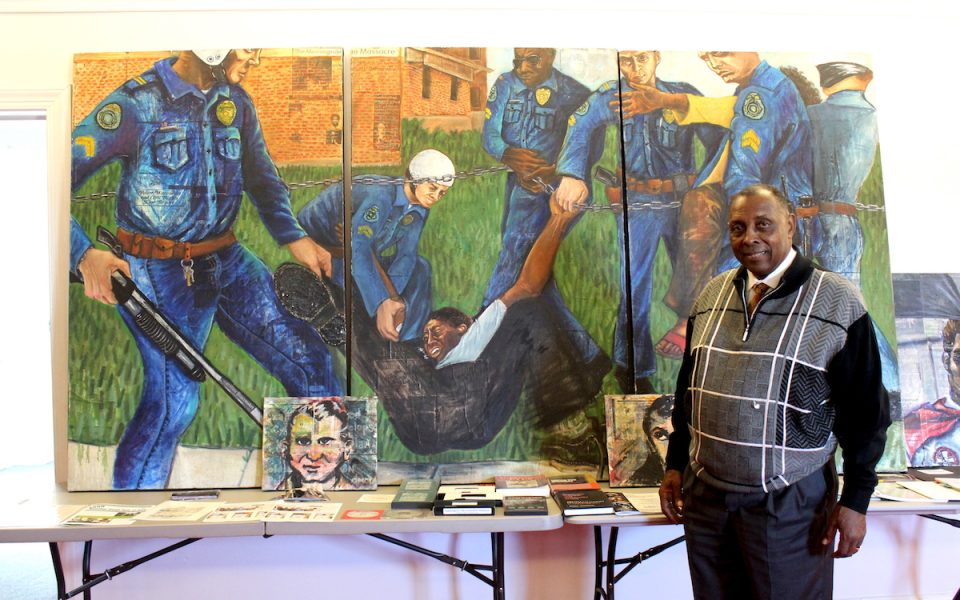“Jim Waller was laying face down, and I went over to him and
turned him over and the air came out of him…. It was his last breath. It was an
exhale and I knew then that this could not have happened without police
complicity.”
Rev. Nelson Johnson remembers the moment like it was
yesterday.
He had just finished fighting off a Nazi who had attacked
him with a knife, cutting into his arms, leaving trails of blood. He stumbled
across the road where lifeless bodies lay on the pavement until he found Jim Waller,
one of the five victims of what would become known as the Greensboro Massacre,
and watched as his friend died.
The black-and-white image of Johnson kneeling next to Waller,
widely circulated, is one of the most well-known images from the event from 40
years ago. But in the front room of the Beloved Community Center, a diptych
brings the scene to color.

Nelson Johnson over Jim Waller’s body (courtesy image)
“I was so determined to show their experiences as accurately
as possible,” says artist Aliene de Souza Howell. “I wanted to honor them and
tell their story.”
The 10 pieces in Howell’s Greensboro Massacre series
sit propped up on fold-out tables at the Beloved Community Center. They portray
various scenes from the killings as well as images and portraits of the KKK and
Nazi members who murdered the victims four decades ago on Nov. 3, 1979. Howell,
who now lives in New York City, was working on her thesis at Guilford College
in 2003 when she first learned about the tragic events.
“The more I learned, the more shocked I was that it had
happened and that I had never heard about it,” she says.
At the time, the push to provide more clarity and visibility
around the events was stirring. Eventually, a truth and reconciliation commission
was established to demand justice for the victims and to bring light and closure
to what had happened. It was around the same time that Howell decided to take
on the task of documenting the event through art.
She tracked down old newspaper articles and read books
written by survivors to get firsthand accounts of the killings. She spoke with
Johnson, who helped organize and survived the massacre and is depicted in a
number of Howell’s paintings.

The largest in the series depicts Johnson as he’s being
dragged off by members of the Greensboro Police Department right after the
shootings.
“Instinctively then, it just flashed in me that these people
had totally set us up,” recalls Johnson about the moment. “I stood up and said
out of all of the energy in my body that the police were part of this… and that
they are responsible for these murders.”
Johnson recalls that when he went to get a permit for the
march about a week before the event, that police Capt. LS Gibson had told
Johnson that he would only be able to get the permit if he signed and promised
that any members associated with the march would not carry any weapons,
concealed or in plain view. And in the moments after KKK and Nazi members drove
up and killed his friends, Johnson said he realized that the police had known a
shootout was going to happen.

In the painting, Johnson struggles as three police officers
grab his arms and legs, lifting his body off the ground. He grabs onto a limp
chain rail, the only thing keeping him anchored to the earth.
Howell says that recreating the image took some creativity
on her part. Using video footage from news crews and a full-length mirror, the
artist recalls contorting her body to look like Johnson’s so she could accurately
depict the way his body was twisting as he was lifted.
She says she worked on the pieces for hours every night for
about a year.
“I saw a lot of sunrises that year,” she says. “When I
finished them, I didn’t know what to do with them; I was in shock.”
And while she didn’t live through the events, Howell says that
researching the massacre and being embedded in the victims and survivors’
stories took a mental toll on her.
“They are such emotional pieces,” she says. “I would stay up
at night and then I would have all these nightmares about the Klan coming after
me.”
-

“Survivor’s Eyes”
Paul Bermanzohn after 3 surgeries from being shot in the head (courtesy image) -

“88 Seconds”
Dale Deering with an EMT trying to save her husband Bill Sampson who died (courtesy image) -

Untitled (courtesy image) -

“Love’s Labor Lost”
Signe Waller hugging Tom Clark after her husband was shot (courtesy image)
Now, Johnson says that the Beloved Community Center is
working with the International Civil Rights Center & Museum in Greensboro
to plan an exhibit to display the works.
“It’s part of a long process of helping this community and
any other people who are interested better understand what happened,” Johnson
says. “I think it’s helpful for people to see some depiction of what actually
happened on that day and the wounds after that.”
Find out more about Aliene de Souza Howell at the artist’s website here.
Join the First Amendment Society, a membership that goes directly to funding TCB‘s newsroom.
We believe that reporting can save the world.
The TCB First Amendment Society recognizes the vital role of a free, unfettered press with a bundling of local experiences designed to build community, and unique engagements with our newsroom that will help you understand, and shape, local journalism’s critical role in uplifting the people in our cities.
All revenue goes directly into the newsroom as reporters’ salaries and freelance commissions.


Leave a Reply